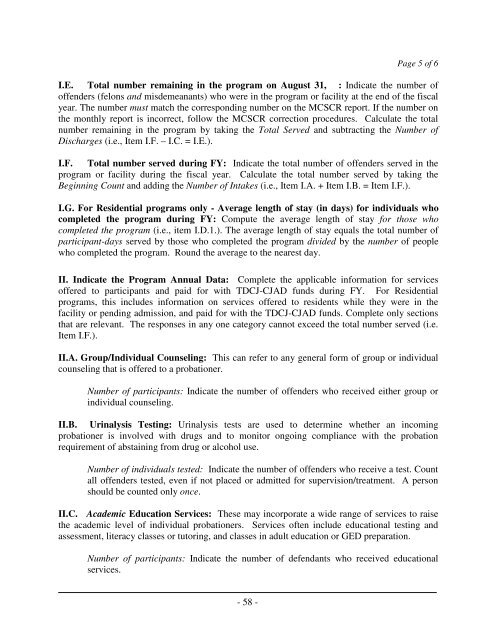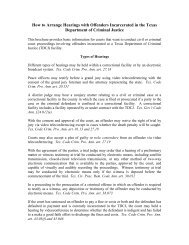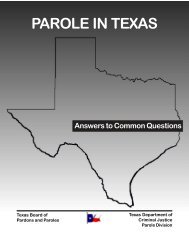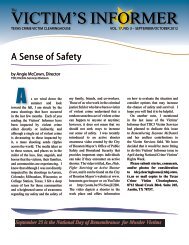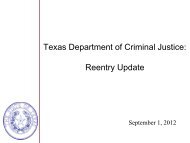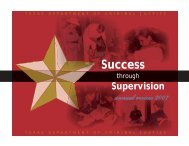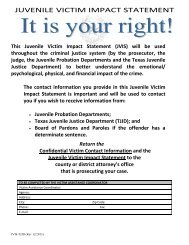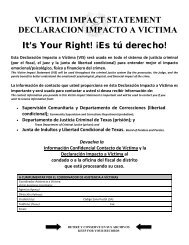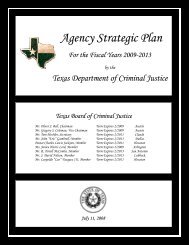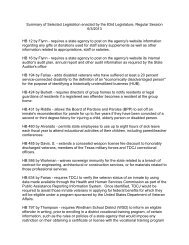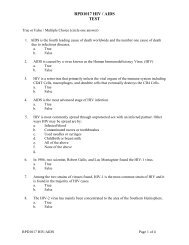TDCJ-CJAD Data Manual - Texas Department of Criminal Justice
TDCJ-CJAD Data Manual - Texas Department of Criminal Justice
TDCJ-CJAD Data Manual - Texas Department of Criminal Justice
Create successful ePaper yourself
Turn your PDF publications into a flip-book with our unique Google optimized e-Paper software.
Page 5 <strong>of</strong> 6I.E. Total number remaining in the program on August 31, : Indicate the number <strong>of</strong><strong>of</strong>fenders (felons and misdemeanants) who were in the program or facility at the end <strong>of</strong> the fiscalyear. The number must match the corresponding number on the MCSCR report. If the number onthe monthly report is incorrect, follow the MCSCR correction procedures. Calculate the totalnumber remaining in the program by taking the Total Served and subtracting the Number <strong>of</strong>Discharges (i.e., Item I.F. – I.C. = I.E.).I.F. Total number served during FY: Indicate the total number <strong>of</strong> <strong>of</strong>fenders served in theprogram or facility during the fiscal year. Calculate the total number served by taking theBeginning Count and adding the Number <strong>of</strong> Intakes (i.e., Item I.A. + Item I.B. = Item I.F.).I.G. For Residential programs only - Average length <strong>of</strong> stay (in days) for individuals whocompleted the program during FY: Compute the average length <strong>of</strong> stay for those whocompleted the program (i.e., item I.D.1.). The average length <strong>of</strong> stay equals the total number <strong>of</strong>participant-days served by those who completed the program divided by the number <strong>of</strong> peoplewho completed the program. Round the average to the nearest day.II. Indicate the Program Annual <strong>Data</strong>: Complete the applicable information for services<strong>of</strong>fered to participants and paid for with <strong>TDCJ</strong>-<strong>CJAD</strong> funds during FY. For Residentialprograms, this includes information on services <strong>of</strong>fered to residents while they were in thefacility or pending admission, and paid for with the <strong>TDCJ</strong>-<strong>CJAD</strong> funds. Complete only sectionsthat are relevant. The responses in any one category cannot exceed the total number served (i.e.Item I.F.).II.A. Group/Individual Counseling: This can refer to any general form <strong>of</strong> group or individualcounseling that is <strong>of</strong>fered to a probationer.Number <strong>of</strong> participants: Indicate the number <strong>of</strong> <strong>of</strong>fenders who received either group orindividual counseling.II.B. Urinalysis Testing: Urinalysis tests are used to determine whether an incomingprobationer is involved with drugs and to monitor ongoing compliance with the probationrequirement <strong>of</strong> abstaining from drug or alcohol use.Number <strong>of</strong> individuals tested: Indicate the number <strong>of</strong> <strong>of</strong>fenders who receive a test. Countall <strong>of</strong>fenders tested, even if not placed or admitted for supervision/treatment. A personshould be counted only once.II.C. Academic Education Services: These may incorporate a wide range <strong>of</strong> services to raisethe academic level <strong>of</strong> individual probationers. Services <strong>of</strong>ten include educational testing andassessment, literacy classes or tutoring, and classes in adult education or GED preparation.Number <strong>of</strong> participants: Indicate the number <strong>of</strong> defendants who received educationalservices.- 58


